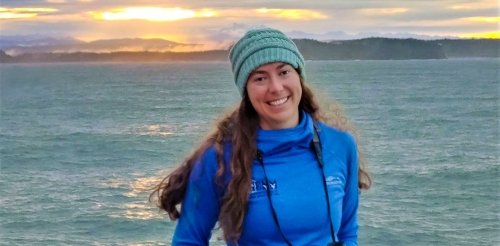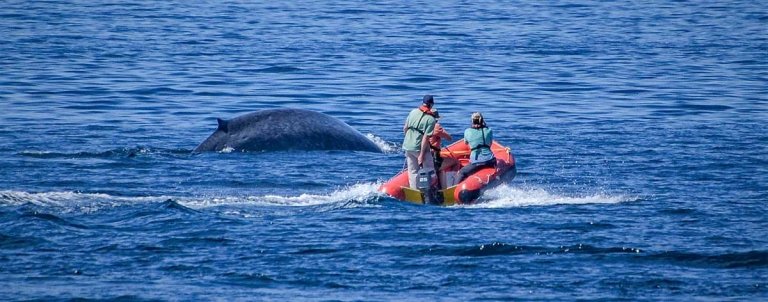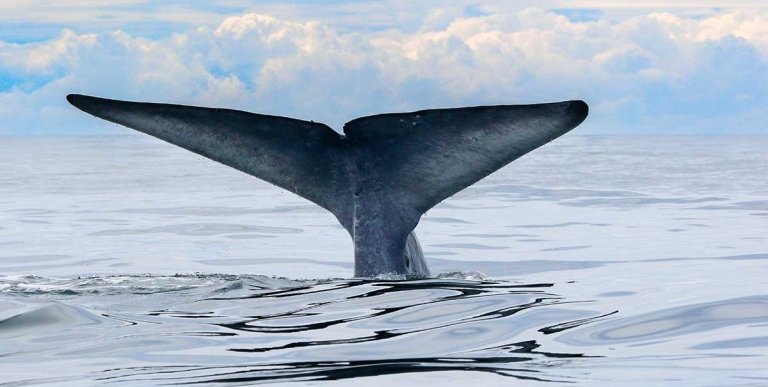The Biology of Making a Difference
Dawn Barlow ’16 is conducting research and analysis in the Pacific Ocean that is shaping policies to preserve vital marine mammals

“I hope that the research I am part of produces the foundational knowledge that is needed to inform policies that shape and drive conservation management.”
Dawn Barlow ’16
Member of Oregon State University’s Marine Mammal Institute
By Mark Cromer
Diving deep into the waters of New Zealand to establish a better understanding of a previously suspected but unconfirmed population of blue whales may sound like a Jacques Cousteau adventure, but for Dawn Barlow ’16, it’s another day at work deciphering mysteries that are critically important to keeping the ocean’s endangered majestic giants on the planet.
A postdoctoral scholar at Oregon State University’s Marine Mammal Institute, Barlow and her colleagues at the institute’s Geospatial Ecology of Marine Megafauna Laboratory have identified, studied, and reported on a unique whale population. The institute’s Leigh Torres first theorized in 2013 that blue whales might be foraging krill in feeding grounds in the South Taranaki Bight region of New Zealand, an area that faces accelerating and expanding effects of energy exploration and ship traffic.
“My field of research involves exploring the relationships between marine mammals and their ecosystems, to better understand their biology and the threats that are posed by human impacts to those ecosystems,” Barlow said. “I hope that the research I am part of produces the foundational knowledge that is needed to inform policies that shape and drive conservation management.”

The human interface with whales has traditionally not favored the oceangoing mammals, and blue whales had been hunted to the edge of extinction as the 20th century got underway. But Barlow and her fellow travelers in the fields of marine biology and public policy are providing key data and takeaways that can form the basis for best practices in preserving the endangered leviathans.
“We have been studying a population of blue whales to understand and document their distribution, ecology, feeding, and reproduction, so that we can also understand the potential impacts of industrial activity,” she said. “Now, we’re also focusing on the impacts of climate change on the health and resilience of these whales and the ecosystem they rely on.”
“The biology major provided me with the background in science that I would need, and the environmental analysis major would lay the groundwork for the policy impacts my research could produce. I am really grateful for the breadth that Pitzer and its programs afforded me on both counts.”
—Dawn Barlow ’16
It has been a journey for Barlow that began in many respects at Pitzer College, which she said she intentionally chose over the bigger R1 universities in marine biology. The focus of many R1 universities extends far beyond teaching to put a high emphasis on groundbreaking research. Barlow was interested in something else.
“I chose Pitzer because I wanted to attend a college that really offered a focus on education. I was interested in having a holistic, well-rounded foundation that would prepare me for the research I would undertake during my graduate studies and beyond, and Pitzer provided me with that experience,” she said.
She fondly recalled how her undergraduate studies prepared her for post-graduate studies and laid the groundwork for success in her professional endeavors on the high seas.

“I was a double major at Pitzer, in organismal biology and environmental policy, which prepared me to pursue a career in marine conservation research,” Barlow said, adding that Pitzer faculty Sarah Gilman, Elise Ferree, and Brinda Sarathy were inspirational educators during her time at the College.
“The biology major provided me with the background in science that I would need, and the environmental analysis major would lay the groundwork for the policy impacts my research could produce. I am really grateful for the breadth that Pitzer and its programs afforded me on both counts.”
As the energy industry continues to envelope the planet with both traditional extraction and emerging platforms such as offshore “wind farms”—currently a relatively small global footprint that is projected to expand significantly in the near future—Barlow said she is studying this situation closer to home.
“I am also involved in research on marine mammals and seabirds of the U.S. West Coast in light of potential offshore wind energy development,” she said. “You can’t understand potential impacts on these species without robust information on when and where they occur—that is the important foundational scientific knowledge that we are collecting and synthesizing.”
While her current research is regionally focused, the findings that the studies produce will most certainly be crucial in easing the weight of humanity’s presence on the planet.
“It can be challenging to be in a field of research studying human impacts on ocean ecosystems and the species that rely on them because the impacts are everywhere. At times, it can be disheartening,” Barlow said. “But enhancing our understanding of these species and ecosystems at local or regional scales and building local partnerships goes a long way, alongside understanding the large-scale impacts of climate change and considering global-scale challenges and solutions. We really are all in this together.”